International Marketing: Second Cup's South Korea Expansion Plan
VerifiedAdded on 2019/09/16
|29
|9915
|229
Report
AI Summary
This report provides a comprehensive analysis of the South Korean market and its potential for Second Cup's expansion. It begins with an executive summary outlining the key aspects of the analysis, including cultural, economic, and political environments. The report then delves into an overview of Second Cup, including its history, growth, resources, market position, and mission. A detailed examination of Second Cup's products and services is also included. The report also explores the opportunities and benefits of Second Cup entering the South Korean market. The report emphasizes the cultural similarities between South Korea and Canada, the high-income economy of South Korea, and the advanced infrastructure that can support Second Cup's operations. The report also discusses the competitive landscape, including Starbucks and Tim Hortons, and the importance of brand awareness and product quality. The paper concludes with a discussion of the potential for Second Cup to generate new coffee flavors adapted to South Korean culture and the benefits of market diversification.
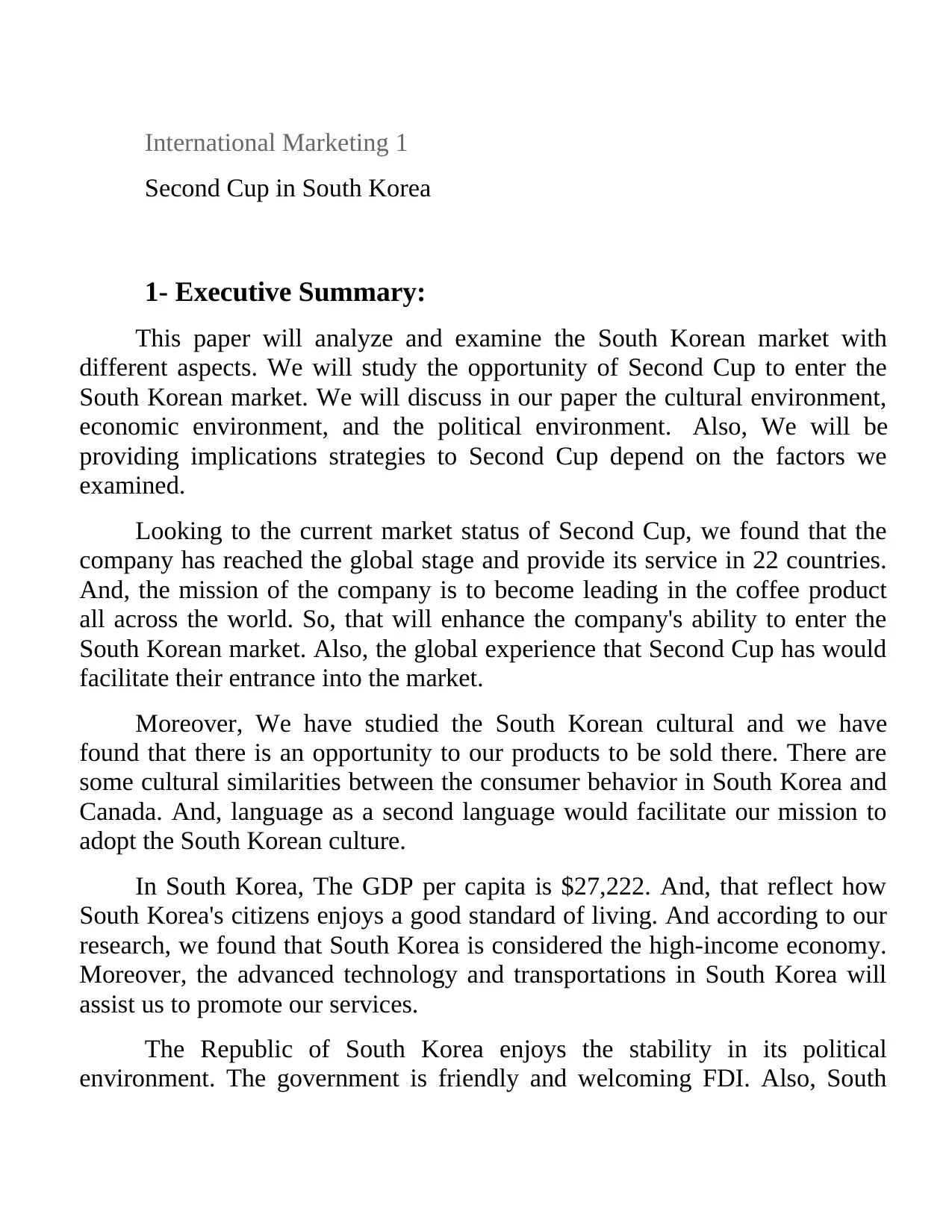
International Marketing 1
Second Cup in South Korea
1- Executive Summary:
This paper will analyze and examine the South Korean market with
different aspects. We will study the opportunity of Second Cup to enter the
South Korean market. We will discuss in our paper the cultural environment,
economic environment, and the political environment. Also, We will be
providing implications strategies to Second Cup depend on the factors we
examined.
Looking to the current market status of Second Cup, we found that the
company has reached the global stage and provide its service in 22 countries.
And, the mission of the company is to become leading in the coffee product
all across the world. So, that will enhance the company's ability to enter the
South Korean market. Also, the global experience that Second Cup has would
facilitate their entrance into the market.
Moreover, We have studied the South Korean cultural and we have
found that there is an opportunity to our products to be sold there. There are
some cultural similarities between the consumer behavior in South Korea and
Canada. And, language as a second language would facilitate our mission to
adopt the South Korean culture.
In South Korea, The GDP per capita is $27,222. And, that reflect how
South Korea's citizens enjoys a good standard of living. And according to our
research, we found that South Korea is considered the high-income economy.
Moreover, the advanced technology and transportations in South Korea will
assist us to promote our services.
The Republic of South Korea enjoys the stability in its political
environment. The government is friendly and welcoming FDI. Also, South
Second Cup in South Korea
1- Executive Summary:
This paper will analyze and examine the South Korean market with
different aspects. We will study the opportunity of Second Cup to enter the
South Korean market. We will discuss in our paper the cultural environment,
economic environment, and the political environment. Also, We will be
providing implications strategies to Second Cup depend on the factors we
examined.
Looking to the current market status of Second Cup, we found that the
company has reached the global stage and provide its service in 22 countries.
And, the mission of the company is to become leading in the coffee product
all across the world. So, that will enhance the company's ability to enter the
South Korean market. Also, the global experience that Second Cup has would
facilitate their entrance into the market.
Moreover, We have studied the South Korean cultural and we have
found that there is an opportunity to our products to be sold there. There are
some cultural similarities between the consumer behavior in South Korea and
Canada. And, language as a second language would facilitate our mission to
adopt the South Korean culture.
In South Korea, The GDP per capita is $27,222. And, that reflect how
South Korea's citizens enjoys a good standard of living. And according to our
research, we found that South Korea is considered the high-income economy.
Moreover, the advanced technology and transportations in South Korea will
assist us to promote our services.
The Republic of South Korea enjoys the stability in its political
environment. The government is friendly and welcoming FDI. Also, South
Paraphrase This Document
Need a fresh take? Get an instant paraphrase of this document with our AI Paraphraser
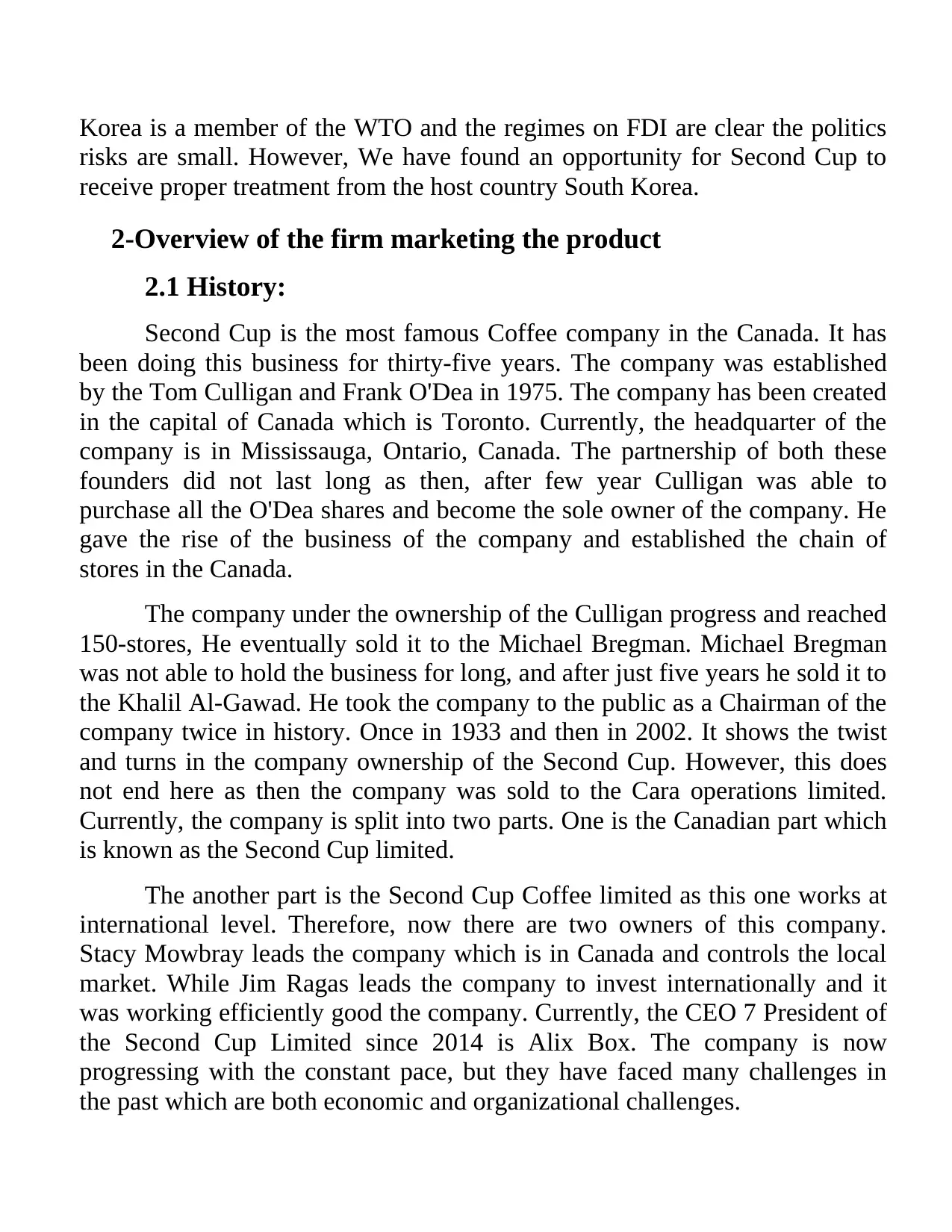
Korea is a member of the WTO and the regimes on FDI are clear the politics
risks are small. However, We have found an opportunity for Second Cup to
receive proper treatment from the host country South Korea.
2-Overview of the firm marketing the product
2.1 History:
Second Cup is the most famous Coffee company in the Canada. It has
been doing this business for thirty-five years. The company was established
by the Tom Culligan and Frank O'Dea in 1975. The company has been created
in the capital of Canada which is Toronto. Currently, the headquarter of the
company is in Mississauga, Ontario, Canada. The partnership of both these
founders did not last long as then, after few year Culligan was able to
purchase all the O'Dea shares and become the sole owner of the company. He
gave the rise of the business of the company and established the chain of
stores in the Canada.
The company under the ownership of the Culligan progress and reached
150-stores, He eventually sold it to the Michael Bregman. Michael Bregman
was not able to hold the business for long, and after just five years he sold it to
the Khalil Al-Gawad. He took the company to the public as a Chairman of the
company twice in history. Once in 1933 and then in 2002. It shows the twist
and turns in the company ownership of the Second Cup. However, this does
not end here as then the company was sold to the Cara operations limited.
Currently, the company is split into two parts. One is the Canadian part which
is known as the Second Cup limited.
The another part is the Second Cup Coffee limited as this one works at
international level. Therefore, now there are two owners of this company.
Stacy Mowbray leads the company which is in Canada and controls the local
market. While Jim Ragas leads the company to invest internationally and it
was working efficiently good the company. Currently, the CEO 7 President of
the Second Cup Limited since 2014 is Alix Box. The company is now
progressing with the constant pace, but they have faced many challenges in
the past which are both economic and organizational challenges.
risks are small. However, We have found an opportunity for Second Cup to
receive proper treatment from the host country South Korea.
2-Overview of the firm marketing the product
2.1 History:
Second Cup is the most famous Coffee company in the Canada. It has
been doing this business for thirty-five years. The company was established
by the Tom Culligan and Frank O'Dea in 1975. The company has been created
in the capital of Canada which is Toronto. Currently, the headquarter of the
company is in Mississauga, Ontario, Canada. The partnership of both these
founders did not last long as then, after few year Culligan was able to
purchase all the O'Dea shares and become the sole owner of the company. He
gave the rise of the business of the company and established the chain of
stores in the Canada.
The company under the ownership of the Culligan progress and reached
150-stores, He eventually sold it to the Michael Bregman. Michael Bregman
was not able to hold the business for long, and after just five years he sold it to
the Khalil Al-Gawad. He took the company to the public as a Chairman of the
company twice in history. Once in 1933 and then in 2002. It shows the twist
and turns in the company ownership of the Second Cup. However, this does
not end here as then the company was sold to the Cara operations limited.
Currently, the company is split into two parts. One is the Canadian part which
is known as the Second Cup limited.
The another part is the Second Cup Coffee limited as this one works at
international level. Therefore, now there are two owners of this company.
Stacy Mowbray leads the company which is in Canada and controls the local
market. While Jim Ragas leads the company to invest internationally and it
was working efficiently good the company. Currently, the CEO 7 President of
the Second Cup Limited since 2014 is Alix Box. The company is now
progressing with the constant pace, but they have faced many challenges in
the past which are both economic and organizational challenges.

2.3 Growth:
Currently, the company has more than 345 stores all across the country
and at international level. The company is serving in 37 regions and 22
countries. There are many international stores of the Second cup like in UK,
USA, Egypt and many other nations. The first branch of the company was
opened in August of 1975. The company was working as small stores in the
shopping mall of Canada, and the reason to choose Kisok shopping mall was
that it has more customer attraction than other malls in the city. The Very
first-day company was able to sell six blends of coffee beans. Although, it was
the small start yet impressive for the enterprise.
The company within a decade progress rapidly and until the late 1980's
company was growing. The chain stores were developed all across the
country, and by 1989, approximately 130 cafes were under the banner of
Second Cup. Not only this the company open stores in the Shopping malls and
Office Towers to attract the market segment. The company broke into the new
market in Quebec in 1990's. It was the new and significant step of the
business. They started growing rapidly and finally in 2003 company stepped
into the international market. After that group start progressing rapidly all
across the world. There are many challenges this company faced during its
way to the International. (Second Cup, 2016)
The biggest problem that this group encounters is the leadership. The
direction of the business changed over time which causes the negative impact
on the company performance. The progress becomes slow when the
management of the company changed. The second challenge is the terrorist
attack. When the company open stores in the Montreal the three stores of the
company were attacked by the terrorist. The reason behind the assault was the
name "Second Cup" of the enterprise. After this incident company reputation
had decreased but they were able to gain the market segment again. (Roger,
2016)
Currently, the company has more than 345 stores all across the country
and at international level. The company is serving in 37 regions and 22
countries. There are many international stores of the Second cup like in UK,
USA, Egypt and many other nations. The first branch of the company was
opened in August of 1975. The company was working as small stores in the
shopping mall of Canada, and the reason to choose Kisok shopping mall was
that it has more customer attraction than other malls in the city. The Very
first-day company was able to sell six blends of coffee beans. Although, it was
the small start yet impressive for the enterprise.
The company within a decade progress rapidly and until the late 1980's
company was growing. The chain stores were developed all across the
country, and by 1989, approximately 130 cafes were under the banner of
Second Cup. Not only this the company open stores in the Shopping malls and
Office Towers to attract the market segment. The company broke into the new
market in Quebec in 1990's. It was the new and significant step of the
business. They started growing rapidly and finally in 2003 company stepped
into the international market. After that group start progressing rapidly all
across the world. There are many challenges this company faced during its
way to the International. (Second Cup, 2016)
The biggest problem that this group encounters is the leadership. The
direction of the business changed over time which causes the negative impact
on the company performance. The progress becomes slow when the
management of the company changed. The second challenge is the terrorist
attack. When the company open stores in the Montreal the three stores of the
company were attacked by the terrorist. The reason behind the assault was the
name "Second Cup" of the enterprise. After this incident company reputation
had decreased but they were able to gain the market segment again. (Roger,
2016)
⊘ This is a preview!⊘
Do you want full access?
Subscribe today to unlock all pages.

Trusted by 1+ million students worldwide
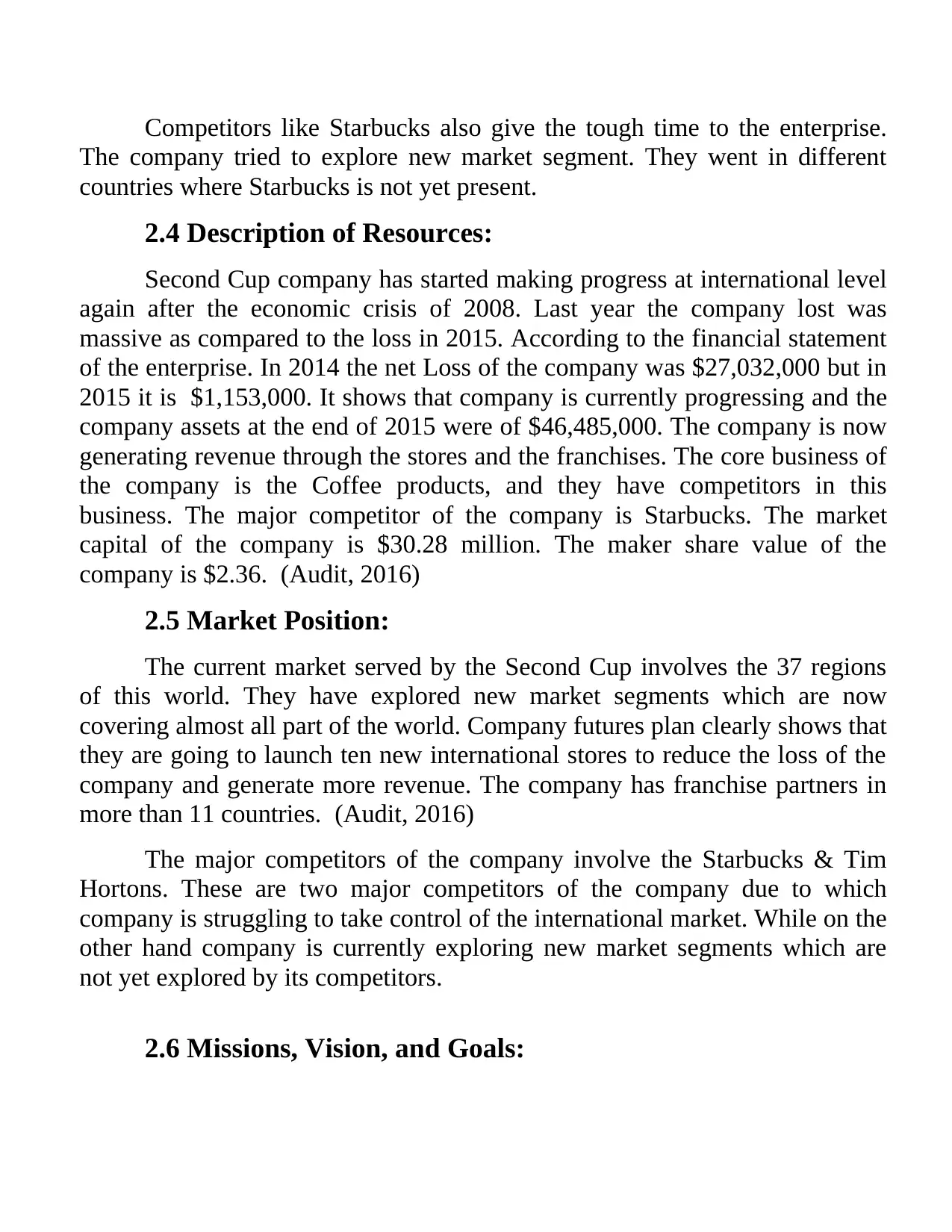
Competitors like Starbucks also give the tough time to the enterprise.
The company tried to explore new market segment. They went in different
countries where Starbucks is not yet present.
2.4 Description of Resources:
Second Cup company has started making progress at international level
again after the economic crisis of 2008. Last year the company lost was
massive as compared to the loss in 2015. According to the financial statement
of the enterprise. In 2014 the net Loss of the company was $27,032,000 but in
2015 it is $1,153,000. It shows that company is currently progressing and the
company assets at the end of 2015 were of $46,485,000. The company is now
generating revenue through the stores and the franchises. The core business of
the company is the Coffee products, and they have competitors in this
business. The major competitor of the company is Starbucks. The market
capital of the company is $30.28 million. The maker share value of the
company is $2.36. (Audit, 2016)
2.5 Market Position:
The current market served by the Second Cup involves the 37 regions
of this world. They have explored new market segments which are now
covering almost all part of the world. Company futures plan clearly shows that
they are going to launch ten new international stores to reduce the loss of the
company and generate more revenue. The company has franchise partners in
more than 11 countries. (Audit, 2016)
The major competitors of the company involve the Starbucks & Tim
Hortons. These are two major competitors of the company due to which
company is struggling to take control of the international market. While on the
other hand company is currently exploring new market segments which are
not yet explored by its competitors.
2.6 Missions, Vision, and Goals:
The company tried to explore new market segment. They went in different
countries where Starbucks is not yet present.
2.4 Description of Resources:
Second Cup company has started making progress at international level
again after the economic crisis of 2008. Last year the company lost was
massive as compared to the loss in 2015. According to the financial statement
of the enterprise. In 2014 the net Loss of the company was $27,032,000 but in
2015 it is $1,153,000. It shows that company is currently progressing and the
company assets at the end of 2015 were of $46,485,000. The company is now
generating revenue through the stores and the franchises. The core business of
the company is the Coffee products, and they have competitors in this
business. The major competitor of the company is Starbucks. The market
capital of the company is $30.28 million. The maker share value of the
company is $2.36. (Audit, 2016)
2.5 Market Position:
The current market served by the Second Cup involves the 37 regions
of this world. They have explored new market segments which are now
covering almost all part of the world. Company futures plan clearly shows that
they are going to launch ten new international stores to reduce the loss of the
company and generate more revenue. The company has franchise partners in
more than 11 countries. (Audit, 2016)
The major competitors of the company involve the Starbucks & Tim
Hortons. These are two major competitors of the company due to which
company is struggling to take control of the international market. While on the
other hand company is currently exploring new market segments which are
not yet explored by its competitors.
2.6 Missions, Vision, and Goals:
Paraphrase This Document
Need a fresh take? Get an instant paraphrase of this document with our AI Paraphraser
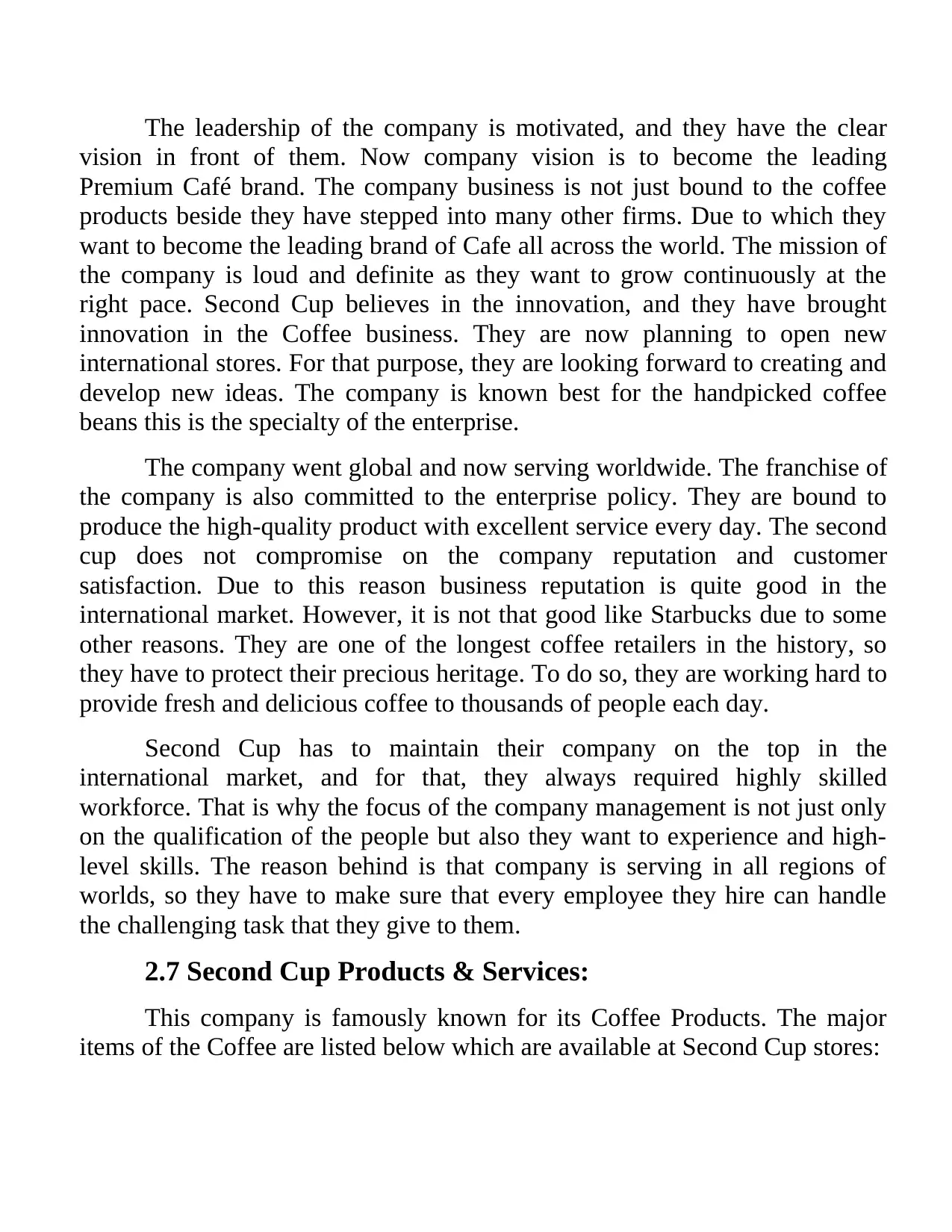
The leadership of the company is motivated, and they have the clear
vision in front of them. Now company vision is to become the leading
Premium Café brand. The company business is not just bound to the coffee
products beside they have stepped into many other firms. Due to which they
want to become the leading brand of Cafe all across the world. The mission of
the company is loud and definite as they want to grow continuously at the
right pace. Second Cup believes in the innovation, and they have brought
innovation in the Coffee business. They are now planning to open new
international stores. For that purpose, they are looking forward to creating and
develop new ideas. The company is known best for the handpicked coffee
beans this is the specialty of the enterprise.
The company went global and now serving worldwide. The franchise of
the company is also committed to the enterprise policy. They are bound to
produce the high-quality product with excellent service every day. The second
cup does not compromise on the company reputation and customer
satisfaction. Due to this reason business reputation is quite good in the
international market. However, it is not that good like Starbucks due to some
other reasons. They are one of the longest coffee retailers in the history, so
they have to protect their precious heritage. To do so, they are working hard to
provide fresh and delicious coffee to thousands of people each day.
Second Cup has to maintain their company on the top in the
international market, and for that, they always required highly skilled
workforce. That is why the focus of the company management is not just only
on the qualification of the people but also they want to experience and high-
level skills. The reason behind is that company is serving in all regions of
worlds, so they have to make sure that every employee they hire can handle
the challenging task that they give to them.
2.7 Second Cup Products & Services:
This company is famously known for its Coffee Products. The major
items of the Coffee are listed below which are available at Second Cup stores:
vision in front of them. Now company vision is to become the leading
Premium Café brand. The company business is not just bound to the coffee
products beside they have stepped into many other firms. Due to which they
want to become the leading brand of Cafe all across the world. The mission of
the company is loud and definite as they want to grow continuously at the
right pace. Second Cup believes in the innovation, and they have brought
innovation in the Coffee business. They are now planning to open new
international stores. For that purpose, they are looking forward to creating and
develop new ideas. The company is known best for the handpicked coffee
beans this is the specialty of the enterprise.
The company went global and now serving worldwide. The franchise of
the company is also committed to the enterprise policy. They are bound to
produce the high-quality product with excellent service every day. The second
cup does not compromise on the company reputation and customer
satisfaction. Due to this reason business reputation is quite good in the
international market. However, it is not that good like Starbucks due to some
other reasons. They are one of the longest coffee retailers in the history, so
they have to protect their precious heritage. To do so, they are working hard to
provide fresh and delicious coffee to thousands of people each day.
Second Cup has to maintain their company on the top in the
international market, and for that, they always required highly skilled
workforce. That is why the focus of the company management is not just only
on the qualification of the people but also they want to experience and high-
level skills. The reason behind is that company is serving in all regions of
worlds, so they have to make sure that every employee they hire can handle
the challenging task that they give to them.
2.7 Second Cup Products & Services:
This company is famously known for its Coffee Products. The major
items of the Coffee are listed below which are available at Second Cup stores:
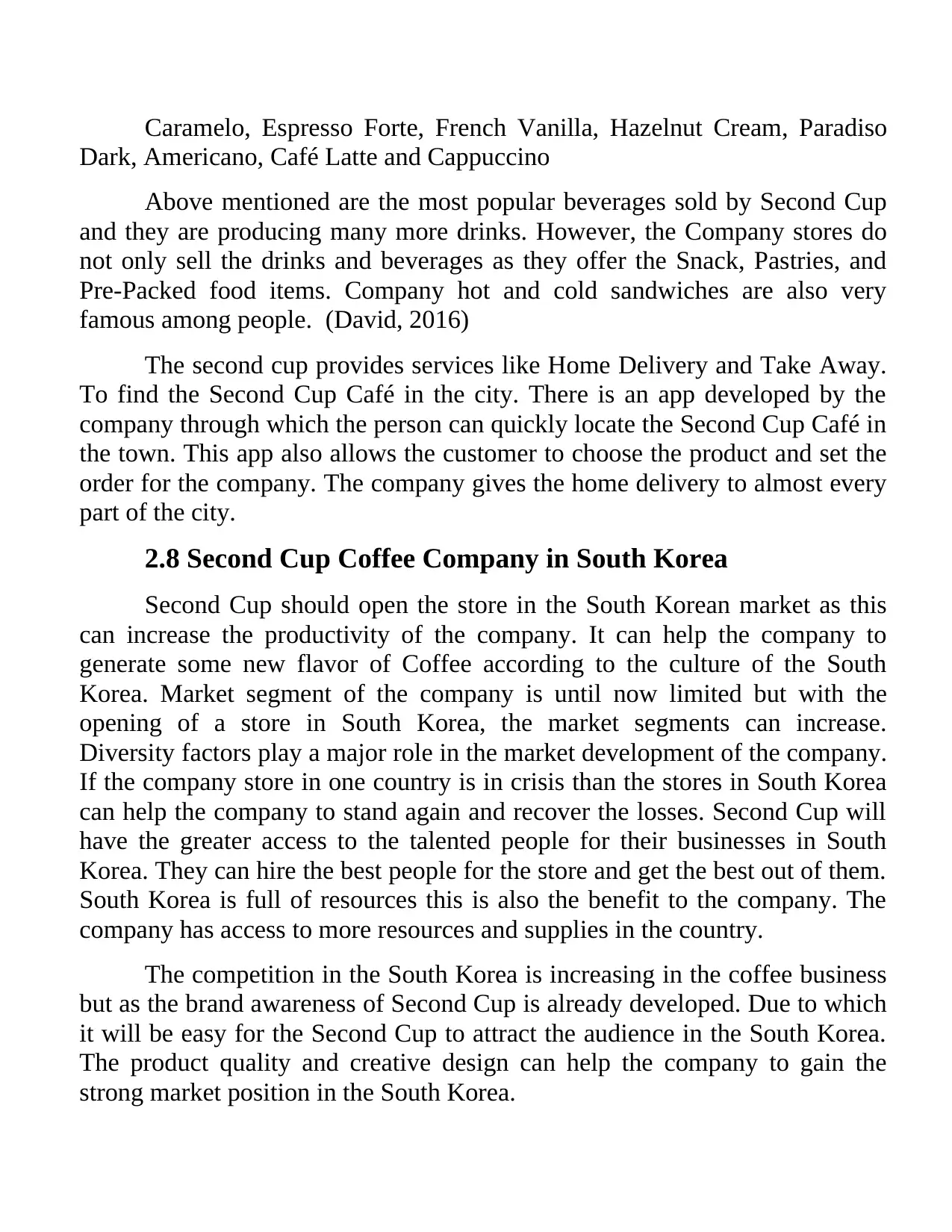
Caramelo, Espresso Forte, French Vanilla, Hazelnut Cream, Paradiso
Dark, Americano, Café Latte and Cappuccino
Above mentioned are the most popular beverages sold by Second Cup
and they are producing many more drinks. However, the Company stores do
not only sell the drinks and beverages as they offer the Snack, Pastries, and
Pre-Packed food items. Company hot and cold sandwiches are also very
famous among people. (David, 2016)
The second cup provides services like Home Delivery and Take Away.
To find the Second Cup Café in the city. There is an app developed by the
company through which the person can quickly locate the Second Cup Café in
the town. This app also allows the customer to choose the product and set the
order for the company. The company gives the home delivery to almost every
part of the city.
2.8 Second Cup Coffee Company in South Korea
Second Cup should open the store in the South Korean market as this
can increase the productivity of the company. It can help the company to
generate some new flavor of Coffee according to the culture of the South
Korea. Market segment of the company is until now limited but with the
opening of a store in South Korea, the market segments can increase.
Diversity factors play a major role in the market development of the company.
If the company store in one country is in crisis than the stores in South Korea
can help the company to stand again and recover the losses. Second Cup will
have the greater access to the talented people for their businesses in South
Korea. They can hire the best people for the store and get the best out of them.
South Korea is full of resources this is also the benefit to the company. The
company has access to more resources and supplies in the country.
The competition in the South Korea is increasing in the coffee business
but as the brand awareness of Second Cup is already developed. Due to which
it will be easy for the Second Cup to attract the audience in the South Korea.
The product quality and creative design can help the company to gain the
strong market position in the South Korea.
Dark, Americano, Café Latte and Cappuccino
Above mentioned are the most popular beverages sold by Second Cup
and they are producing many more drinks. However, the Company stores do
not only sell the drinks and beverages as they offer the Snack, Pastries, and
Pre-Packed food items. Company hot and cold sandwiches are also very
famous among people. (David, 2016)
The second cup provides services like Home Delivery and Take Away.
To find the Second Cup Café in the city. There is an app developed by the
company through which the person can quickly locate the Second Cup Café in
the town. This app also allows the customer to choose the product and set the
order for the company. The company gives the home delivery to almost every
part of the city.
2.8 Second Cup Coffee Company in South Korea
Second Cup should open the store in the South Korean market as this
can increase the productivity of the company. It can help the company to
generate some new flavor of Coffee according to the culture of the South
Korea. Market segment of the company is until now limited but with the
opening of a store in South Korea, the market segments can increase.
Diversity factors play a major role in the market development of the company.
If the company store in one country is in crisis than the stores in South Korea
can help the company to stand again and recover the losses. Second Cup will
have the greater access to the talented people for their businesses in South
Korea. They can hire the best people for the store and get the best out of them.
South Korea is full of resources this is also the benefit to the company. The
company has access to more resources and supplies in the country.
The competition in the South Korea is increasing in the coffee business
but as the brand awareness of Second Cup is already developed. Due to which
it will be easy for the Second Cup to attract the audience in the South Korea.
The product quality and creative design can help the company to gain the
strong market position in the South Korea.
⊘ This is a preview!⊘
Do you want full access?
Subscribe today to unlock all pages.

Trusted by 1+ million students worldwide
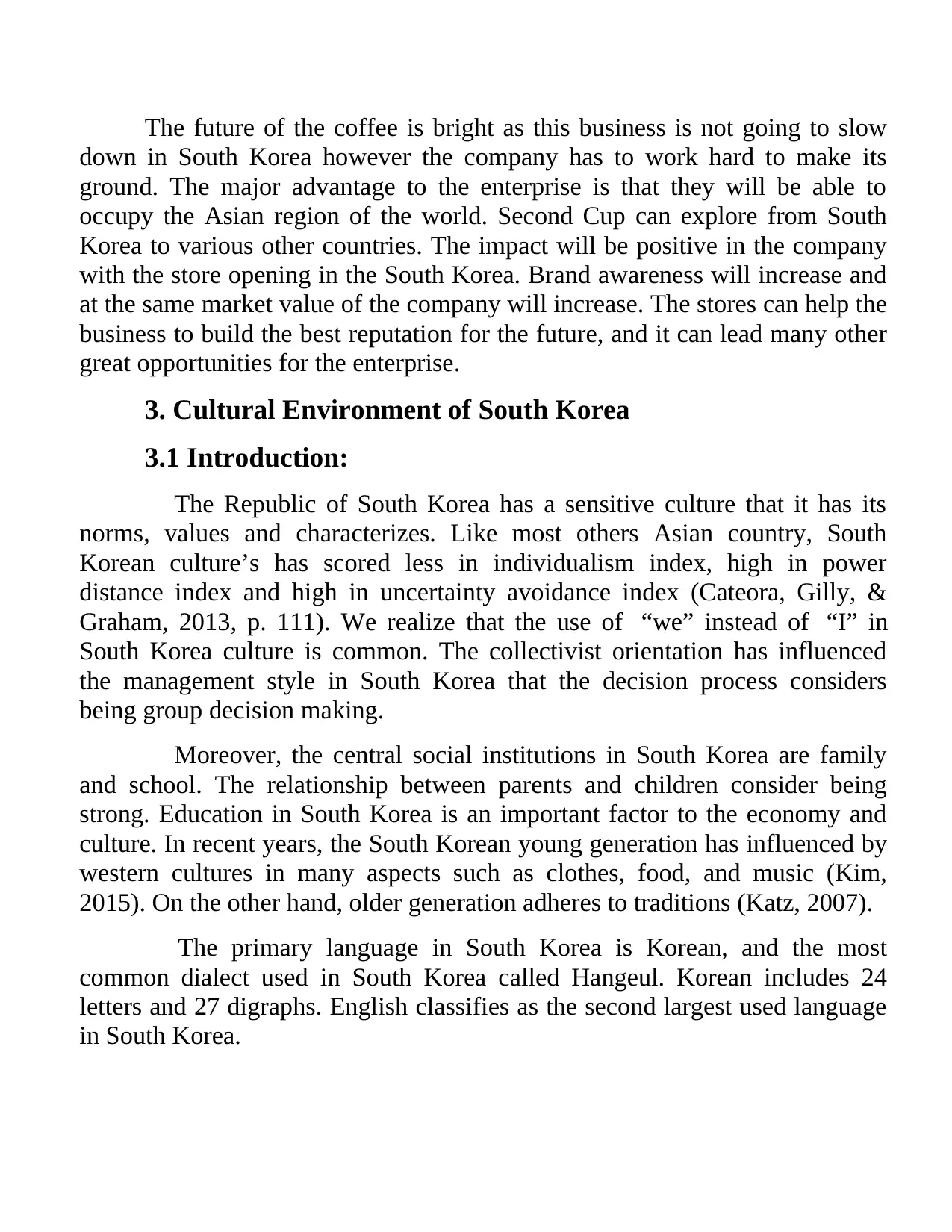
The future of the coffee is bright as this business is not going to slow
down in South Korea however the company has to work hard to make its
ground. The major advantage to the enterprise is that they will be able to
occupy the Asian region of the world. Second Cup can explore from South
Korea to various other countries. The impact will be positive in the company
with the store opening in the South Korea. Brand awareness will increase and
at the same market value of the company will increase. The stores can help the
business to build the best reputation for the future, and it can lead many other
great opportunities for the enterprise.
3. Cultural Environment of South Korea
3.1 Introduction:
The Republic of South Korea has a sensitive culture that it has its
norms, values and characterizes. Like most others Asian country, South
Korean culture’s has scored less in individualism index, high in power
distance index and high in uncertainty avoidance index (Cateora, Gilly, &
Graham, 2013, p. 111). We realize that the use of “we” instead of “I” in
South Korea culture is common. The collectivist orientation has influenced
the management style in South Korea that the decision process considers
being group decision making.
Moreover, the central social institutions in South Korea are family
and school. The relationship between parents and children consider being
strong. Education in South Korea is an important factor to the economy and
culture. In recent years, the South Korean young generation has influenced by
western cultures in many aspects such as clothes, food, and music (Kim,
2015). On the other hand, older generation adheres to traditions (Katz, 2007).
The primary language in South Korea is Korean, and the most
common dialect used in South Korea called Hangeul. Korean includes 24
letters and 27 digraphs. English classifies as the second largest used language
in South Korea.
down in South Korea however the company has to work hard to make its
ground. The major advantage to the enterprise is that they will be able to
occupy the Asian region of the world. Second Cup can explore from South
Korea to various other countries. The impact will be positive in the company
with the store opening in the South Korea. Brand awareness will increase and
at the same market value of the company will increase. The stores can help the
business to build the best reputation for the future, and it can lead many other
great opportunities for the enterprise.
3. Cultural Environment of South Korea
3.1 Introduction:
The Republic of South Korea has a sensitive culture that it has its
norms, values and characterizes. Like most others Asian country, South
Korean culture’s has scored less in individualism index, high in power
distance index and high in uncertainty avoidance index (Cateora, Gilly, &
Graham, 2013, p. 111). We realize that the use of “we” instead of “I” in
South Korea culture is common. The collectivist orientation has influenced
the management style in South Korea that the decision process considers
being group decision making.
Moreover, the central social institutions in South Korea are family
and school. The relationship between parents and children consider being
strong. Education in South Korea is an important factor to the economy and
culture. In recent years, the South Korean young generation has influenced by
western cultures in many aspects such as clothes, food, and music (Kim,
2015). On the other hand, older generation adheres to traditions (Katz, 2007).
The primary language in South Korea is Korean, and the most
common dialect used in South Korea called Hangeul. Korean includes 24
letters and 27 digraphs. English classifies as the second largest used language
in South Korea.
Paraphrase This Document
Need a fresh take? Get an instant paraphrase of this document with our AI Paraphraser
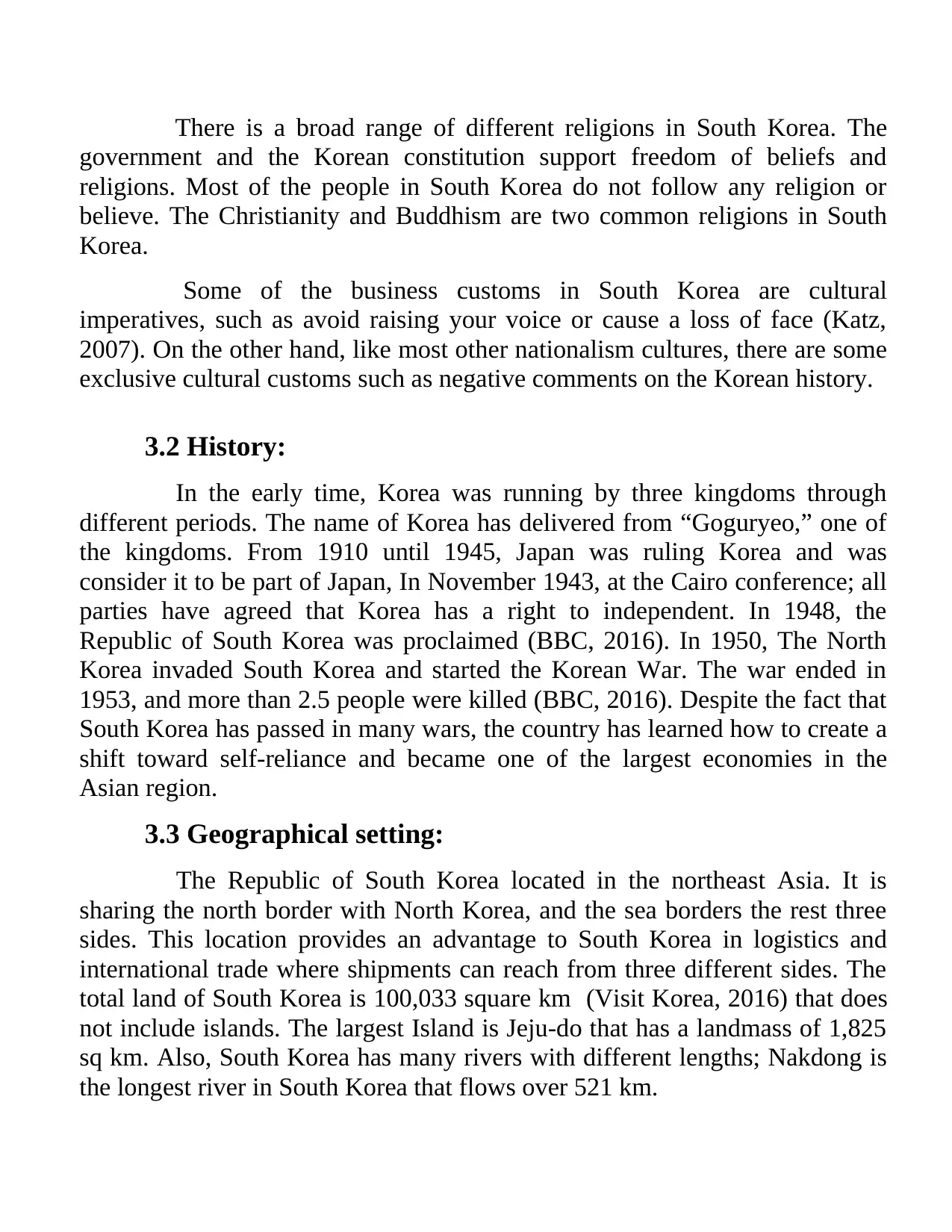
There is a broad range of different religions in South Korea. The
government and the Korean constitution support freedom of beliefs and
religions. Most of the people in South Korea do not follow any religion or
believe. The Christianity and Buddhism are two common religions in South
Korea.
Some of the business customs in South Korea are cultural
imperatives, such as avoid raising your voice or cause a loss of face (Katz,
2007). On the other hand, like most other nationalism cultures, there are some
exclusive cultural customs such as negative comments on the Korean history.
3.2 History:
In the early time, Korea was running by three kingdoms through
different periods. The name of Korea has delivered from “Goguryeo,” one of
the kingdoms. From 1910 until 1945, Japan was ruling Korea and was
consider it to be part of Japan, In November 1943, at the Cairo conference; all
parties have agreed that Korea has a right to independent. In 1948, the
Republic of South Korea was proclaimed (BBC, 2016). In 1950, The North
Korea invaded South Korea and started the Korean War. The war ended in
1953, and more than 2.5 people were killed (BBC, 2016). Despite the fact that
South Korea has passed in many wars, the country has learned how to create a
shift toward self-reliance and became one of the largest economies in the
Asian region.
3.3 Geographical setting:
The Republic of South Korea located in the northeast Asia. It is
sharing the north border with North Korea, and the sea borders the rest three
sides. This location provides an advantage to South Korea in logistics and
international trade where shipments can reach from three different sides. The
total land of South Korea is 100,033 square km (Visit Korea, 2016) that does
not include islands. The largest Island is Jeju-do that has a landmass of 1,825
sq km. Also, South Korea has many rivers with different lengths; Nakdong is
the longest river in South Korea that flows over 521 km.
government and the Korean constitution support freedom of beliefs and
religions. Most of the people in South Korea do not follow any religion or
believe. The Christianity and Buddhism are two common religions in South
Korea.
Some of the business customs in South Korea are cultural
imperatives, such as avoid raising your voice or cause a loss of face (Katz,
2007). On the other hand, like most other nationalism cultures, there are some
exclusive cultural customs such as negative comments on the Korean history.
3.2 History:
In the early time, Korea was running by three kingdoms through
different periods. The name of Korea has delivered from “Goguryeo,” one of
the kingdoms. From 1910 until 1945, Japan was ruling Korea and was
consider it to be part of Japan, In November 1943, at the Cairo conference; all
parties have agreed that Korea has a right to independent. In 1948, the
Republic of South Korea was proclaimed (BBC, 2016). In 1950, The North
Korea invaded South Korea and started the Korean War. The war ended in
1953, and more than 2.5 people were killed (BBC, 2016). Despite the fact that
South Korea has passed in many wars, the country has learned how to create a
shift toward self-reliance and became one of the largest economies in the
Asian region.
3.3 Geographical setting:
The Republic of South Korea located in the northeast Asia. It is
sharing the north border with North Korea, and the sea borders the rest three
sides. This location provides an advantage to South Korea in logistics and
international trade where shipments can reach from three different sides. The
total land of South Korea is 100,033 square km (Visit Korea, 2016) that does
not include islands. The largest Island is Jeju-do that has a landmass of 1,825
sq km. Also, South Korea has many rivers with different lengths; Nakdong is
the longest river in South Korea that flows over 521 km.

There are different sizes of cities in South Korea. Seoul is the capital
city of and located in the northwest of the country. It considers being the city
of business in South Korea. Then, Busan it comes after, it is located in the
southeast of the country map, and it is the second largest city after Seoul.
The climate in South Korea is regularly comparing to Asian countries.
The country enjoys the four seasons during the year. The winter season is
typically long and cold; on the other hand, the summer is short and hot.
Temperatures vary from city to city. For example, on the north side such as
Seoul, the temperature in January is -5 and 22.5 in July while on the south
shore of Jeju Island, the temperature in winter is 2.5 and 25 in summer (Visit
Korea, 2016). The country has a right amount of rainfall during the year. The
yearly rainfall is around 1,000 millimeters that give an opportunity to the state
to maintain improvement in the agriculture sector.
3.4 Family:
The family is one of the primary social institutions in South Korea. Like
many Asian cultures, People in South Korea have obligations toward their
family. The parents’ role is to raise children and be responsible for their
expenses and education. The men are accountable for the financial side, and
women are responsible for the house and kids. Also, involving in most
decisions of the children such as marriage. In return to that, kids are treating
their parents with respect all the time and taking care of them when they get
older (Asia Society, 2016).
Despite the fact that Korean well- structured family is important to the
society, today many changes have happened to the family’s structure in the
major cities in South Korea. Adults have started to live independently from
their parents, and children have the freedom to decide and choose their future
partner without parent’s permission (Asia Society, 2016).
However, most families from generation X are still maintaining the
traditional structure of the household. Disintegrations of the family’s structure
are common in the couple or families from generation y. Furthermore, the role
city of and located in the northwest of the country. It considers being the city
of business in South Korea. Then, Busan it comes after, it is located in the
southeast of the country map, and it is the second largest city after Seoul.
The climate in South Korea is regularly comparing to Asian countries.
The country enjoys the four seasons during the year. The winter season is
typically long and cold; on the other hand, the summer is short and hot.
Temperatures vary from city to city. For example, on the north side such as
Seoul, the temperature in January is -5 and 22.5 in July while on the south
shore of Jeju Island, the temperature in winter is 2.5 and 25 in summer (Visit
Korea, 2016). The country has a right amount of rainfall during the year. The
yearly rainfall is around 1,000 millimeters that give an opportunity to the state
to maintain improvement in the agriculture sector.
3.4 Family:
The family is one of the primary social institutions in South Korea. Like
many Asian cultures, People in South Korea have obligations toward their
family. The parents’ role is to raise children and be responsible for their
expenses and education. The men are accountable for the financial side, and
women are responsible for the house and kids. Also, involving in most
decisions of the children such as marriage. In return to that, kids are treating
their parents with respect all the time and taking care of them when they get
older (Asia Society, 2016).
Despite the fact that Korean well- structured family is important to the
society, today many changes have happened to the family’s structure in the
major cities in South Korea. Adults have started to live independently from
their parents, and children have the freedom to decide and choose their future
partner without parent’s permission (Asia Society, 2016).
However, most families from generation X are still maintaining the
traditional structure of the household. Disintegrations of the family’s structure
are common in the couple or families from generation y. Furthermore, the role
⊘ This is a preview!⊘
Do you want full access?
Subscribe today to unlock all pages.

Trusted by 1+ million students worldwide
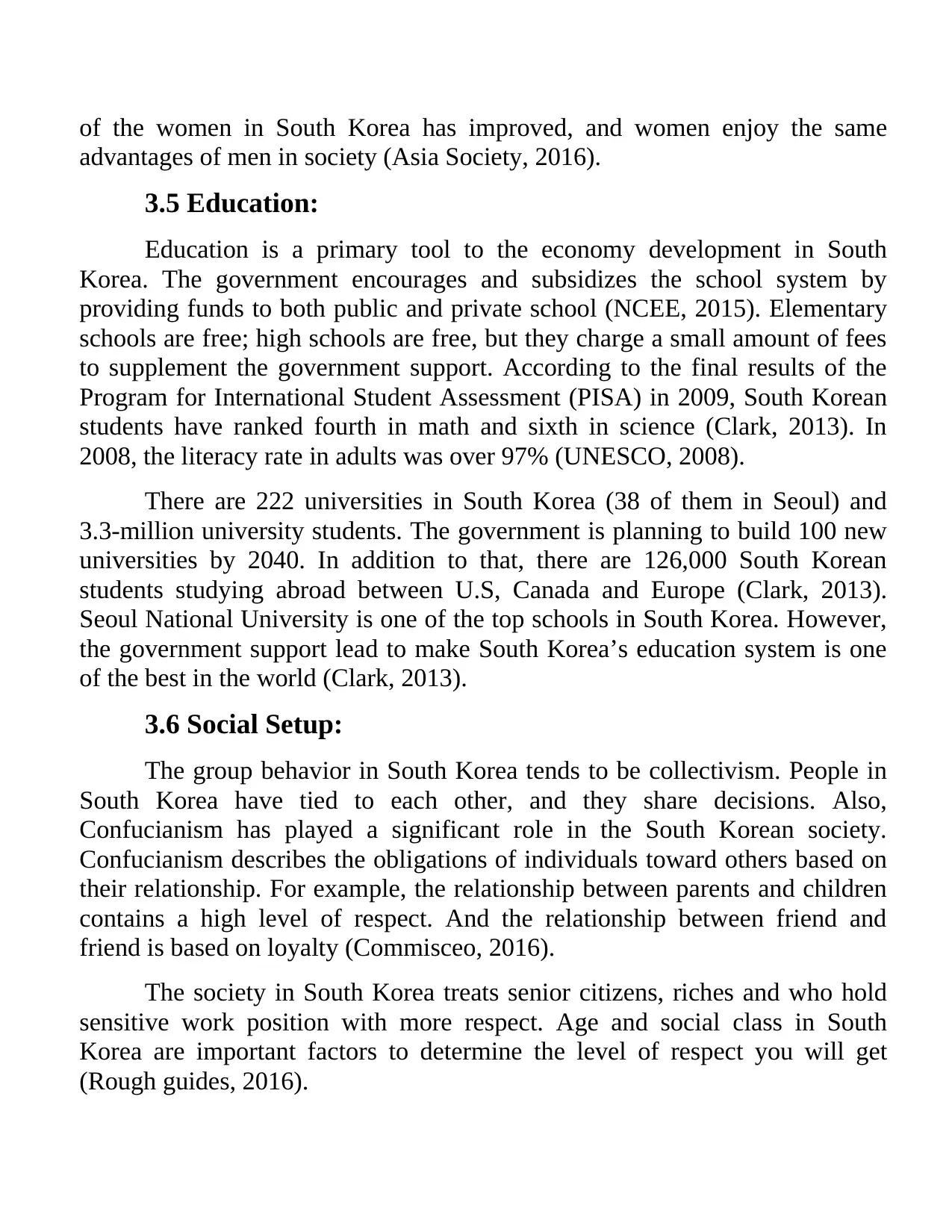
of the women in South Korea has improved, and women enjoy the same
advantages of men in society (Asia Society, 2016).
3.5 Education:
Education is a primary tool to the economy development in South
Korea. The government encourages and subsidizes the school system by
providing funds to both public and private school (NCEE, 2015). Elementary
schools are free; high schools are free, but they charge a small amount of fees
to supplement the government support. According to the final results of the
Program for International Student Assessment (PISA) in 2009, South Korean
students have ranked fourth in math and sixth in science (Clark, 2013). In
2008, the literacy rate in adults was over 97% (UNESCO, 2008).
There are 222 universities in South Korea (38 of them in Seoul) and
3.3-million university students. The government is planning to build 100 new
universities by 2040. In addition to that, there are 126,000 South Korean
students studying abroad between U.S, Canada and Europe (Clark, 2013).
Seoul National University is one of the top schools in South Korea. However,
the government support lead to make South Korea’s education system is one
of the best in the world (Clark, 2013).
3.6 Social Setup:
The group behavior in South Korea tends to be collectivism. People in
South Korea have tied to each other, and they share decisions. Also,
Confucianism has played a significant role in the South Korean society.
Confucianism describes the obligations of individuals toward others based on
their relationship. For example, the relationship between parents and children
contains a high level of respect. And the relationship between friend and
friend is based on loyalty (Commisceo, 2016).
The society in South Korea treats senior citizens, riches and who hold
sensitive work position with more respect. Age and social class in South
Korea are important factors to determine the level of respect you will get
(Rough guides, 2016).
advantages of men in society (Asia Society, 2016).
3.5 Education:
Education is a primary tool to the economy development in South
Korea. The government encourages and subsidizes the school system by
providing funds to both public and private school (NCEE, 2015). Elementary
schools are free; high schools are free, but they charge a small amount of fees
to supplement the government support. According to the final results of the
Program for International Student Assessment (PISA) in 2009, South Korean
students have ranked fourth in math and sixth in science (Clark, 2013). In
2008, the literacy rate in adults was over 97% (UNESCO, 2008).
There are 222 universities in South Korea (38 of them in Seoul) and
3.3-million university students. The government is planning to build 100 new
universities by 2040. In addition to that, there are 126,000 South Korean
students studying abroad between U.S, Canada and Europe (Clark, 2013).
Seoul National University is one of the top schools in South Korea. However,
the government support lead to make South Korea’s education system is one
of the best in the world (Clark, 2013).
3.6 Social Setup:
The group behavior in South Korea tends to be collectivism. People in
South Korea have tied to each other, and they share decisions. Also,
Confucianism has played a significant role in the South Korean society.
Confucianism describes the obligations of individuals toward others based on
their relationship. For example, the relationship between parents and children
contains a high level of respect. And the relationship between friend and
friend is based on loyalty (Commisceo, 2016).
The society in South Korea treats senior citizens, riches and who hold
sensitive work position with more respect. Age and social class in South
Korea are important factors to determine the level of respect you will get
(Rough guides, 2016).
Paraphrase This Document
Need a fresh take? Get an instant paraphrase of this document with our AI Paraphraser

3.7 Religion:
The people in South Korea enjoy the freedom of religion; the
government respects the right of religion practices. The Majority of the
Korean citizens 41% does not practice any religion. The Christianity is the
most common religion in South Korea, 31% of the people follows it, and then
Buddhist with 26% (CIA, 2010). However, religion and believe are not
adequate, stable factors that could affect trade in South Korea (Ramírez, &
Rubio, 2010).
3.8 Business customs and practices:
In South Korea, business customs are critical and sensitive. There are
almost protocol and etiquettes for all business and trade aspects. Some of the
cultural imperatives are required in business deals such as; greeting and avoid
causing a loss of face. Some are electives where foreign can participate but
not required such as, have your business card translated into Korean. Finally,
there are cultural exclusive customs, for example, disrespect of South Korean
traditions.
Moreover, People in South Korea are strict with time, be on time is a
major factor to meet Korean business customs. Also, it is advised that always
be ready to exchange business cards in the first meeting and show interest in
reading it (Commisceo, 2016).
3.9 Aesthetics:
Most of the arts in South Korea derived from its history and traditions.
There are several of impressive visual arts in South Korea. Since the era of
Goryeo (700 years ago), the art of the Korean pottery has introduced. There
are many great designs, and most of them are unique. Today, Korean potteries
especially jars attracts from foreign buyers (Korea.net, 2016).
Printing is another major art in South Korea. It has introduced in the
12th century. The artists were capturing the daily life of early South Korean
people. In fact, printing art is one of the sources that describe the history of
South Korea.
The people in South Korea enjoy the freedom of religion; the
government respects the right of religion practices. The Majority of the
Korean citizens 41% does not practice any religion. The Christianity is the
most common religion in South Korea, 31% of the people follows it, and then
Buddhist with 26% (CIA, 2010). However, religion and believe are not
adequate, stable factors that could affect trade in South Korea (Ramírez, &
Rubio, 2010).
3.8 Business customs and practices:
In South Korea, business customs are critical and sensitive. There are
almost protocol and etiquettes for all business and trade aspects. Some of the
cultural imperatives are required in business deals such as; greeting and avoid
causing a loss of face. Some are electives where foreign can participate but
not required such as, have your business card translated into Korean. Finally,
there are cultural exclusive customs, for example, disrespect of South Korean
traditions.
Moreover, People in South Korea are strict with time, be on time is a
major factor to meet Korean business customs. Also, it is advised that always
be ready to exchange business cards in the first meeting and show interest in
reading it (Commisceo, 2016).
3.9 Aesthetics:
Most of the arts in South Korea derived from its history and traditions.
There are several of impressive visual arts in South Korea. Since the era of
Goryeo (700 years ago), the art of the Korean pottery has introduced. There
are many great designs, and most of them are unique. Today, Korean potteries
especially jars attracts from foreign buyers (Korea.net, 2016).
Printing is another major art in South Korea. It has introduced in the
12th century. The artists were capturing the daily life of early South Korean
people. In fact, printing art is one of the sources that describe the history of
South Korea.
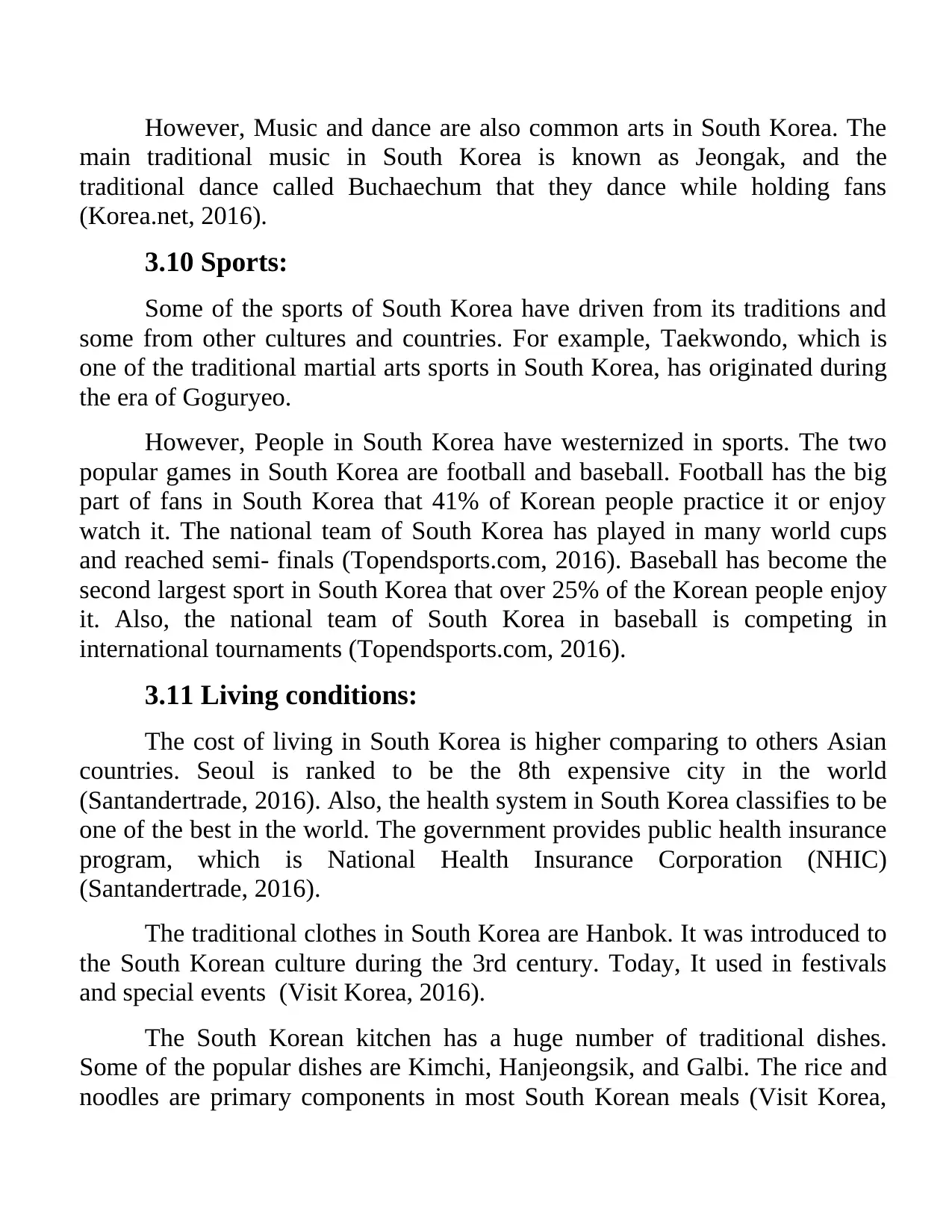
However, Music and dance are also common arts in South Korea. The
main traditional music in South Korea is known as Jeongak, and the
traditional dance called Buchaechum that they dance while holding fans
(Korea.net, 2016).
3.10 Sports:
Some of the sports of South Korea have driven from its traditions and
some from other cultures and countries. For example, Taekwondo, which is
one of the traditional martial arts sports in South Korea, has originated during
the era of Goguryeo.
However, People in South Korea have westernized in sports. The two
popular games in South Korea are football and baseball. Football has the big
part of fans in South Korea that 41% of Korean people practice it or enjoy
watch it. The national team of South Korea has played in many world cups
and reached semi- finals (Topendsports.com, 2016). Baseball has become the
second largest sport in South Korea that over 25% of the Korean people enjoy
it. Also, the national team of South Korea in baseball is competing in
international tournaments (Topendsports.com, 2016).
3.11 Living conditions:
The cost of living in South Korea is higher comparing to others Asian
countries. Seoul is ranked to be the 8th expensive city in the world
(Santandertrade, 2016). Also, the health system in South Korea classifies to be
one of the best in the world. The government provides public health insurance
program, which is National Health Insurance Corporation (NHIC)
(Santandertrade, 2016).
The traditional clothes in South Korea are Hanbok. It was introduced to
the South Korean culture during the 3rd century. Today, It used in festivals
and special events (Visit Korea, 2016).
The South Korean kitchen has a huge number of traditional dishes.
Some of the popular dishes are Kimchi, Hanjeongsik, and Galbi. The rice and
noodles are primary components in most South Korean meals (Visit Korea,
main traditional music in South Korea is known as Jeongak, and the
traditional dance called Buchaechum that they dance while holding fans
(Korea.net, 2016).
3.10 Sports:
Some of the sports of South Korea have driven from its traditions and
some from other cultures and countries. For example, Taekwondo, which is
one of the traditional martial arts sports in South Korea, has originated during
the era of Goguryeo.
However, People in South Korea have westernized in sports. The two
popular games in South Korea are football and baseball. Football has the big
part of fans in South Korea that 41% of Korean people practice it or enjoy
watch it. The national team of South Korea has played in many world cups
and reached semi- finals (Topendsports.com, 2016). Baseball has become the
second largest sport in South Korea that over 25% of the Korean people enjoy
it. Also, the national team of South Korea in baseball is competing in
international tournaments (Topendsports.com, 2016).
3.11 Living conditions:
The cost of living in South Korea is higher comparing to others Asian
countries. Seoul is ranked to be the 8th expensive city in the world
(Santandertrade, 2016). Also, the health system in South Korea classifies to be
one of the best in the world. The government provides public health insurance
program, which is National Health Insurance Corporation (NHIC)
(Santandertrade, 2016).
The traditional clothes in South Korea are Hanbok. It was introduced to
the South Korean culture during the 3rd century. Today, It used in festivals
and special events (Visit Korea, 2016).
The South Korean kitchen has a huge number of traditional dishes.
Some of the popular dishes are Kimchi, Hanjeongsik, and Galbi. The rice and
noodles are primary components in most South Korean meals (Visit Korea,
⊘ This is a preview!⊘
Do you want full access?
Subscribe today to unlock all pages.

Trusted by 1+ million students worldwide
1 out of 29
Your All-in-One AI-Powered Toolkit for Academic Success.
+13062052269
info@desklib.com
Available 24*7 on WhatsApp / Email
![[object Object]](/_next/static/media/star-bottom.7253800d.svg)
Unlock your academic potential
Copyright © 2020–2025 A2Z Services. All Rights Reserved. Developed and managed by ZUCOL.
